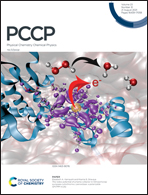Ultrafast Laplace NMR to study metal–ligand interactions in reversible polarisation transfer from parahydrogen†
Abstract
Laplace Nuclear Magnetic Resonance (NMR) can determine relaxation parameters and diffusion constants, giving valuable information about molecular structure and dynamics. Information about relaxation times (T1 and T2) and the self-diffusion coefficient (D) can be extracted from exponentially decaying NMR signals by performing a Laplace transform, which is a different approach to traditional NMR involving Fourier transform of a free induction decay. Ultrafast Laplace NMR uses spatial encoding to collect the entire data set in just a single scan which provides orders of magnitude time savings. In this work we use ultrafast Laplace NMR D–T2 correlation sequences to measure key relaxation (T2) and diffusion (D) parameters of methanolic solutions containing pyridine. For the first time we combine this technique with the hyperpolarisation technique Signal Amplification By Reversible Exchange (SABRE), which employs an iridium catalyst to reversibly transfer polarisation from parahydrogen, to boost the 1H NMR signals of pyridine by up to 300-fold. We demonstrate use of ultrafast Laplace NMR to monitor changes in pyridine T2 and D associated with ligation to the iridium SABRE catalyst and kinetic isotope exchange reactions. The combined 1440-fold reduction in experiment time and 300-fold 1H NMR signal enhancement allow the determination of pyridine D coefficients and T2 values at 25 mM concentrations in just 3 seconds using SABRE hyperpolarised ultrafast Laplace NMR.

- This article is part of the themed collection: 2021 PCCP HOT Articles


 Please wait while we load your content...
Please wait while we load your content...